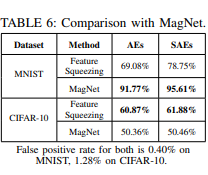こんにちは、futabatoです。
今回は、Feature Squeezing: Detecting Adversarial Examples in Deep Neural Networks (Xu, Weilin, David Evans, and Yanjun Qi., 2017)の論文に目を通したので、論文メモとしてBlogに残しておきます。
Feature Squeezing: Detecting Adversarial Examples in Deep Neural Networks
論文の概要
- 著者: Xu, Weilin, David Evans, and Yanjun Qi.
- 年度: 2017
- 論文URL: https://arxiv.org/abs/1704.01155
- 被引用数: 1167
- タグ:
Preprocess,Supplementing the Network
本論文の手法に代表されるように、モデルに入力されるデータに対して前処理を行うことで誤分類を防ぐ手法があります。
特徴量の入力空間が不必要に大きく、その広大さがAdversarial Examples構築する機会を提供してしまっているということに注目して、不要な入力を絞り込む(squeezing)することで攻撃者が利用できる自由度を減らそうとしています。

Abstract
Although deep neural networks (DNNs) have achieved great success in many tasks, they can often be fooled by adversarial examples that are generated by adding small but purposeful distortions to natural examples. Previous studies to defend against adversarial examples mostly focused on refining the DNN models, but have either shown limited success or required expensive computation. We propose a new strategy, feature squeezing, that can be used to harden DNN models by detecting adversarial examples. Feature squeezing reduces the search space available to an adversary by coalescing samples that correspond to many different feature vectors in the original space into a single sample. By comparing a DNN model’s prediction on the original input with that on squeezed inputs, feature squeezing detects adversarial examples with high accuracy and few false positives. This paper explores two feature squeezing methods: reducing the color bit depth of each pixel and spatial smoothing. These simple strategies are inexpensive and complementary to other defenses, and can be combined in a joint detection framework to achieve high detection rates against state-of-the-art attacks.
既存研究と比べてどこが凄い?
これまでの研究ではDNNモデルを改良することが中心で、その効果は限定的で、しかも高度な計算が必要になるものだった。本論文で紹介されているfeature squeezingは比較的安価で他の防御手法と補完的であるため、他の検出フレームワークと組み合わせて多層防御することで最先端の攻撃に対して高い検出率を達成できた。
技術や手法のキモはどこ?
Color Depth

上記Figure 2を見ると、中断と下段の画像は、8bitの原画像と4bitに絞った画像の違いを見極めるのは困難である一方で、上段の画像と違い4bit以下の色深度では人間が観察可能な損失が発生している。これは1channelあたりのbit数が同じでもRGBの3channel分の情報が失われるからである。
とはいえ、8bitから4bitへの圧縮は、Legitimate Examplesに対する精度を維持しながら、多くの敵対的な例を軽減するのに十分強力であることがわかった。
Spatial Smoothing
画像処理で登場する空間フィルタリングは画像のノイズ低減のために広く使われている手法である。
以下のようなフィルタ処理を適用することで、エッジを維持しつつ画像全体(あるいは局所的に)ぼかすことができる。
- Gaussian Filter
- Median Filter
- Averaging Filter
- binary Filter

どうやって有効だと検証した?
静的な敵対的入力に複数のsqueezersを組み合わせた検出器を利用して、MNISTで98%、CIFAR-10で85%、ImageNetで85%の検出率を出した。False Positive rateも5%程度と低く、Adversarial Examplesをうまく検出できていることがわかった。


議論はある?
色深度と平滑化以外にも、JPEG画像の品質や次元削減に着目してAdversarial Examplesを弾く研究がされている。
legitimate inputsに対する潜在的な損失が評価されていなかったり、固有顔による画像復元は、顔認識タスクにおける敵対的摂動を緩和する有用な手法である可能性があるため、まだ開拓の余地が見受けられる。
次に読むべき論文は?
MagNetというAdversarial Examplesに対する防御手法が存在するらしい。MagNetパイプラインはend-to-endで微分可能なため、trivial white-box adversaryには脆弱らしい。
最後までご覧いただきありがとうございました。